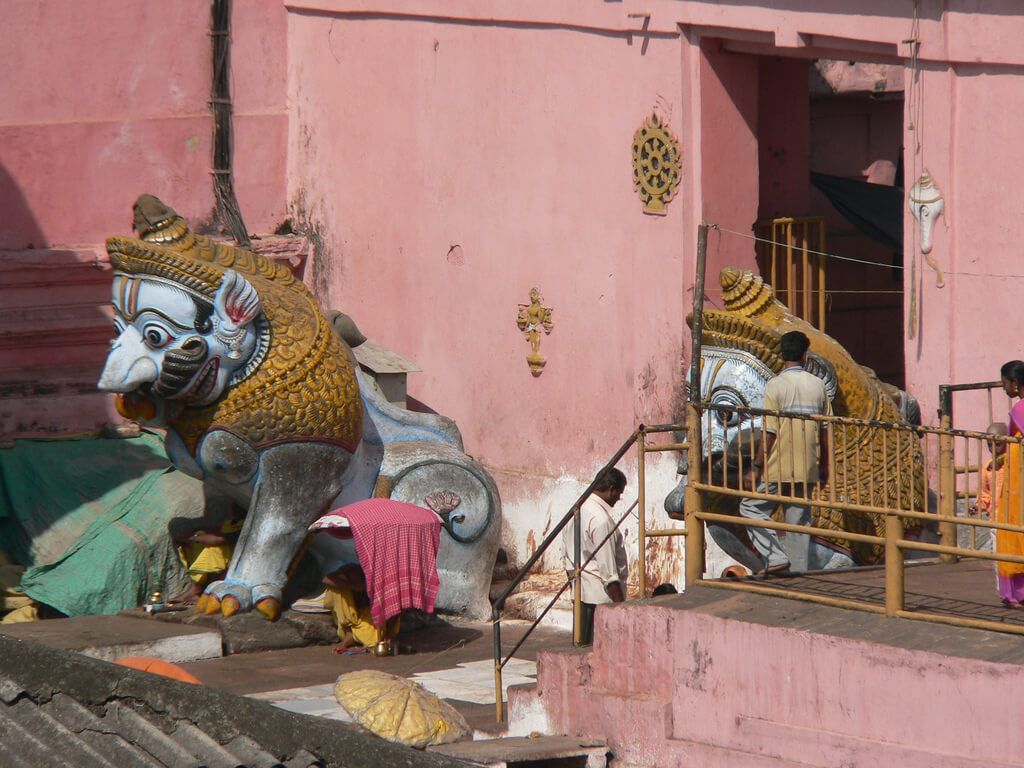Near the shimmering sands of the Golden Beach and the sparkling shore of the Mahodadhi, lies the conch-shaped city of Puri. The great river’s waters shimmer with glee as the first rays of the crimson sun touch them. The exquisitely carved black chlorite figure of Aruna, Surya’s celestial charioteer, present on top of a massive column in front of the Singhadwara, shines under the soft glow of the rising Sun. The waves of Mahodadhi dance on the tides, as if paying their obeisances to this great temple that stands by its shores since time immemorial.

At the break of dawn, in the holy temple, three of the four gates of the temple are opened. But the actual, huge massive gates are not the ones that are opened. At five o’clock, some specific sevayats enter the temple through much smaller, concealed doors in the larger metallic doors. These smaller ‘doors’ are called Chora Kabata, literally ‘Secret Door’. The sevayats enter into the temple premises to awaken the Lord from his restful sleep.
But it’s not as simple as that.
It is not so simple to awaken the ‘Lord of the Cosmos’ from his repose. Just like every other ritual in the Jagannatha Temple, this one too has a number of tasks.
Of course, before them, the temple guards inspect every nook and corner. The sevayats who do these early morning rituals are the Pratihari, Bhitarachu Mahapatra, Muduli, Mekapa, and Akhanda Mekapa. These servitors first gather at the Southern(Elephant) Gate or Dakshina Dwara, and then proceed towards the main temple. They go to the Jaya-Vijaya door of the Natamandapa (The terms refer to architectural components and specific doors). This door is locked by an earthen seal a day before, during the nighttime rituals. Now, the seal is inspected, and the lock is opened with the key. The key is taken from the Muduli sevayat, who keeps it through the night.
Now all of them enter into the main temple, specifically the Jagamohana, and reach the inner door to the sanctum sanctorum. This door, called the Kalahata Dwara, or the Chhamu Dwara,with abeautifully ornamented doorjamb gilded with silver, is then opened.
But before that, there’s another thing to be done.
Before that, the Pratihari Sevaka calls at the top of his voice, to wake up the Lord lest he be sleeping while the door is opened. He calls aloud-

Only after that do they open the door to see a wonderful sight. As the Mekapa & the Akhanda Mekapa light a lamp, the darkness is dispelled by the flickering light of the lamp, to reveal one of the most captivating sights- the three deities, in their Nighttime attire, the Badasinghara Besha, adorned with all sorts of flower-ornaments, their round eyes looking through the net of fragrant flowers. In this way, the Mekapa and the Akhanda Mekapa light nine huge brass lamps. All the doors in the temple are then opened completely.
Then do the Pushpalakas enter the sanctum sanctorum and perform the morning ritual of waving the sacred fire before the deities, or Aarti. The Pushpalakas do the ritual with the help of the Mekapas and the Mahapatra sevayats. This Aarti or Alati(aa-la-ti) ritual has 3 steps-
- The first is done with Camphor, called Karpura Alati.
- The second with 21 lamps of Ghee, is called Ekoishi Batti Alati, as it is done with twenty-one lamps.
- The third with liquid batter of moistened rice, called Pithau. Hence this alati is called Pithau Batti Alati.
These three steps together are called the Morning Alati, or Mangala Alati. So, the Mangala Alati marks the beginning of the day in the Jagannatha Temple.
An important thing is that the devotees can see the entire Mangala Alati. This is because, after opening the Southern Gate, Bhitarachu Mahapatra orders for the four main gates to be completely opened, so that people may enter the temple precincts. Again, after the Khata-sheja mekapas keep aside the ivory beds of the deities, called Ratnapalanka, the other doors- namely the Sata Pahacha Dwara, the Panda Dwara, the Beharana Dwara are opened in the order. The general public then view the deities, standing near the Bhitara-katha-argali.( that is, the stout wooden bars put just after the sanctum sanctorum to keep the people from entering the sanctum sanctorum while rituals are going on)
Thus commences the day in Jagannatha’s abode.